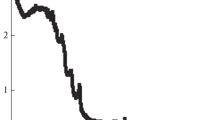Summary
LiF crystals containing uranium show two bands at 240 and 305 nm with half-widths 0.99 and 0.54 eV respectively. Low temperatures (77 °K) reduce the half-width of the 305 nm band to 0.94 eV and shifts it to 290 nm. No new bands are found at room temperature in KCl:U. At 77 °K uranium-doped KCl crystals show two bands at 234 and 270 nm. In LiF:U, on X-irradiation the band at 305 nm decreases. The growth rate of theF-centres is found to be faster in uranium-doped LiF crystals. Two new bands, at 900 and 980 nm, are found in X-irradiated uranium-doped LiF crystals. These bands are found to be stable up to 150 °C. The values of energies derived from the conductivity plot areW s=2.68 eV for the energy of formation of a separated pair of vacanciesE=0.72 eV for the energy of activation for the migration of a cation vacancy andW a=0.51 eV for the energy of association of a cation vacancy with a uranium centre in LiF and 0.45 eV in KCl. Uncoloured LiF:U and KCl:U give rise to a broad EPR line at room temperature. At low temperature (77 °K) this narrows down to 150 G in KCl. On X-irradiation these signals are reduced in intensity.
Riassunto
I cristalli di LiF contenenti uranio mostrano due bande a 240 e 305 nm con semiampiezza rispettivamente di 0.99 e 0.54 eV. A temperature basse (77 °K) la semiampiezza della banda di 305 nm si riduce a 0.94 eV e si sposta a 290 nm. Non si trovano nuove bande a temperatura ambiente in KCl:U. A 77 °K si riscontrano nei cristalli KCl drogati con uranio due bande a 234 e 270 nm. Nel LiF:U in seguito a irraggiamento da raggi X la banda a 305 nm diminuisce. Il rapporto di crescita dei centriF risulta essere più veloce nei cristalli LiF drogati con uranio. Si trovano due nuove bande, a 900 e 980 nm, nei cristalli di LiF drogati con uranio sottoponendoli a irraggiamento da raggi X. Queste bande risultano stabili fino a 150 °C. I valori dell’energia derivati dalla curva di conduttività sonoW s=2.68 eV per l’energia di formazione di una coppia separata di vacanzeE=0.72 eV per l’energia di attivazione per la migrazione di una vacanza cationica eW a=0.51 eV per l’energia di associazione di una vacanza cationica con un centro di uranio in LiF e 0.45 eV in KCl. LiF:U e KCl:U danno origine ad una linea estesa EPR alla temperatura ambiente. A bassa temperatura (77 °K) questa si limita a 150 G in KCl. Per irraggiamento da raggi X questi segnali sono ridotti d’intensità.
Реэюме
Кристаллы LiF, содержашие уран, обнаруживают две эоны при 240 и 305 nm с полущиринами 0.99 и 0.54 зВ, соответственно. При ниэких температурах (77 °K) происходит уменьщение полущирины эоны 305 nm до 0.94 зВ и смешение ее к 290 nm. При комнатной температуре не обнаружено новых эон в KCl:U. При температуре 77 °K кристаллы KC1 с присаженным ураном обнаруживают две эоны 234 и 270 nm. При облучении рентгеновскими лучами эона в LiF:U при 305 nm уменьщается. Установлено, что скорость ростаF центров окаэывается больщей в кристаллах LiF с присаженным ураном. При облучении рентгеновскими лучами кристаллов LiF с присаженным ураном обнаружены две новых эоны при 900 и 980 nm. Обнаружено, что зти эоны являются устойчивыми вплоть до 150 °C. Величины знергий, полученные иэ кривой проводимости, составляютW s=2.68 зВ для знергии обраэования отдельной пары вакансий,E=0.72 зВ для знергии активации для миг-рации катионной вакансии иW a=0.51 зВ для знергии ассоциации катионной вакансии с урановым центром в LiF, и 0.45 зВ в KCl. Неокращенные LiF:U и KCl:U приводят к воэникновению щирокой EPR линии при комнатной температуре. При ниэкой температуре (77 °K) она ссужается до 150 гаусс в KCl. При облучении рентгеновскими лучами уменьщается интенсивность зтих сигналов.
Similar content being viewed by others
References
K. Kubo:Journ. Phys. Soc. Japan,16, 2294 (1961).
P. Gorlich, H. Karras andG. Kolitz:Phys. Stat. Sol.,3, 1629 (1963).
M. Dubois, P. Berge andG. Blanc:Disc. Farad. Soc.,31, 167 (1961).
S. C. Jain andG. D. Sootha:Phys. Stat. Sol.,22, 505 (1967).
A. A. Kaplyanskii andN. A. Moskvin:Optics and Spectr.,13, 542 (1962);14, 357 (1963).
S. K. Agarwal andA. P. Kulshresta:Ind. Journ. Pure and Appl. Phys.,5, 535 (1967).
S. C. Jain andP. C. Mehendru:Phys. Rev.,140, A 957 (1965).
S. C. Jain andG. D. Sootha:Journ. Phys. Chem. Solids,26, 267 (1965).
J. L. Ryan andC. K. Jorgenson:Mol. Phys.,7, 17 (1963).
J. H. Schulman andW. D. Compton:Color Centers in Solids (London, 1963).
P. Suptitz andJ. Teltow:Phys. Stat. Sol.,23, 9 (1967).
Author information
Authors and Affiliations
Rights and permissions
About this article
Cite this article
Sootha, G.D., Radhakrishna, S. & Agarwal, S.K. Optical and electrical properties of uranium-doped LiF and KCl. Nuovo Cimento B (1965-1970) 64, 19–27 (1969). https://doi.org/10.1007/BF02710279
Received:
Published:
Issue Date:
DOI: https://doi.org/10.1007/BF02710279




